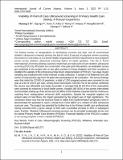| dc.contributor.author | Matiang'i, Micah | |
| dc.contributor.author | Ngunju, Priscillah | |
| dc.contributor.author | Koen, J | |
| dc.contributor.author | Kiilu, C. | |
| dc.contributor.author | Romy, H. | |
| dc.contributor.author | Hetyey, A. | |
| dc.contributor.author | Hangelbroek, Marianne | |
| dc.contributor.author | Opanga, Yvonne | |
| dc.contributor.author | Ndoria, S. | |
| dc.date.accessioned | 2022-09-19T12:47:39Z | |
| dc.date.available | 2022-09-19T12:47:39Z | |
| dc.date.issued | 2022-09-07 | |
| dc.identifier.citation | M, M., P, N., J, K., C, K., H, R., H, A., M, H., Y, O., & S, N. (2022). Viability of Point of Care Ultrasound screening in Primary Health Care Setting: A Kenyan Experience. International Journal of Current Aspects, 6(3), 1-13. https://doi.org/10.35942/ijcab.v6i3.273 | en_US |
| dc.identifier.issn | 2707-8035 | |
| dc.identifier.uri | https://journals.ijcab.org/journals/index.php/ijcab/article/view/273/248 | |
| dc.identifier.uri | https://repository.amref.ac.ke/handle/123456789/807 | |
| dc.description.abstract | The limited number of sonographers in developing countries and high cost of conventional obstetric ultrasound screening services has led to only 6.9 percent of pregnant women accessing the service in rural areas. It is a World Health Organization (WHO) requirement to have pregnant women access obstetric ultrasound screening before 24 weeks gestation. This led to Amref
International University piloting a business model that can make point of care obstetric ultrasound screening (POCUS) affordable and sustainable. One-year post intervention, an evaluation survey got conducted in the project sites in two pilot counties in Kenya (Kajiado and Kisii counties) to establish the viability of the entrepreneurship driven implementation of POCUS. Two stage cluster
sampling was employed with mixed methods of data collection. A sample of 33 Midwives and 196 women of reproductive age from the pilot sites participated in the evaluation. The survey findings were that midst the COVID-19 pandemic, a total of 1250 pregnant women were screened in one year at a fee of USD 5 per scan. Among those interviewed, 168 (85.7%) of the women confirmed the service was affordable and easily accessible. It emerged that 85 (43.4%) of the respondents were screened by midwives in local health centres. Notably,180 (91%) of the women interviewed recommended scaling up of the service and 32 (96%) of the midwives reported that the continuous coaching from radiographers enhanced skills acquisition. Despite the marginal negative net present value of cash flows, the impact generated by the project was of high significance. The conclusion drawn was that the business model is viable from implementation perspective since it demonstrated the potential to reach a Break-Even Point (BEP) at a modest of 1833 ultrasound scans per year. The project has potential for further buy-in by Primary health care professionals having accorded them a gross margin of 60% with a probable increase to 80% in subsequent years. Further, Obstetric Ultrasound screening services can be provided sustainably at low cost by trained Primary Health Care Workers (PHCWs). Financial viability of the POCUS is subject to increasing pregnant women’s access to POCUS. | en_US |
| dc.language.iso | en_US | en_US |
| dc.publisher | International Journal of Current Aspects | en_US |
| dc.subject | Point of Care Ultrasonography Screening (POCUS) | en_US |
| dc.subject | Midwives | en_US |
| dc.subject | Antenatal care | en_US |
| dc.subject | Business Model | en_US |
| dc.subject | Obstetric ultrasound screening | en_US |
| dc.title | Viability of Point of Care Ultrasound screening in Primary Health Care Setting: A Kenyan Experience | en_US |
| dc.type | Article, Journal | en_US |

